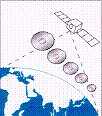 |
INTERNATIONAL SYMPOSIUM ON INFORMATION TECHNOLOGY IN OCEANOGRAPHY (ITO-98) GOA, INDIA 12-16 OCTOBER 1998 |
 |
INTERNATIONAL SYMPOSIUM ON INFORMATION TECHNOLOGY IN OCEANOGRAPHY (ITO-98) GOA, INDIA 12-16 OCTOBER 1998 |
Commissioning of a Sea Level Station
at Mormugao harbour
and improvement of some sea
level gauges
Vijay Kumar, Vani B.Peshwe, Antony Joseph, Elgar Desa,
Ehrlich
Desa and R.G.Prabbu Desai
National Institute of Oceanography, Dona Paula, Goa, India
Under sea level monitoring and modeling programme (SELMAM) sponsored by the Department of Ocean Development, National Institute of Oceanography (NIO) established a sea level station adjacent to the existing tide station at Mormugao harbour, Goa, India. In addition to the existing float-type analog gauge of the Survey of India, two conventional stilling-wells were erected for deployment of a float-type digital gauge (FTDG) and a pressure gauge. Subsequently a guided air-acoustic gauge was also established. The primary motivation behind commissioning of this sea level station was to quality-assess differing sea level gauges and carry out possible improvements to enhance their performance. In one of the wells a temperature compensated quartz pressure transducer was deployed which provided time-averaged water pressure values at 6-minutes intervals, which were recorded in an in-house designed logger with suitable time tagging. The pressure data were subsequently converted to tidal height via the density of sea water column above the sensor. Since the analog float-gauge data was too noisy for comparison purposes, a float-driven tape-pulley mechanism was also erected in the well for inter-comparison. To take care of the daily and seasonal variations of water density, a dual-pressure gauge system was subsequently developed and deployed. From a knowledge of the vertical height of the water column between the pressure inlets of these two pressure sensors, the value of density could be autonomously estimated during each sampling of pressure data. Thus, an inherent limitation of a single-pressure gauge could be removed with the use of this system (patent filed).
Flow- and wave-induced influences on the accuracy of sea level measurements was significantly improved with the use of a parallel-plate geometry at the inlets of the two pressure transducers. In order to study the effect of trapping of low-density water in a stilling-well, density measurements of water inside and outside of a stilling-well were made over a period of 3 years. These measurements have indicated that the effect is more predominant immediately after southwest monsoon. Methodologies have been developed to remove the low density water trapping effect (patent filed), and measurements are currently being carried out to study the effectiveness of the improved stilling-well. Two inherent problems associated with the guided air-acoustic gauge at Mormugao harbour were degradation of sea level measurements arising from trapping of low-density water (inherent in any conventional stilling-well/protective well) and temperature gradient in its sounding tube. We could reduce the latter error by temperature profile measurements, from outside of the sounding tube and within the protective well, together with sea level measurements. However, an apparent lag in the thermal response of the PVC sounding tube has made it difficult to achieve a complete correction to the temperature gradient effect. Thus, establishment of a sea level station at Mormugoa harbour and its management by NIO (1991-98) served the useful purpose of gaining new in sights into the methodologies and improvements of sea level measurements
[ITO - 98] [Welcome] [1998 - Internetional Year of the Oceans] [Objectives of ITO-98] [Plenary Lectures] [Technical Sessions] [Commercial/Corporate Presentation] [Exhibition/Demonstration] [Ocean IT CDROM] [Awards/Financial Assistance] [Fees / Charges] [Souvenir] [Post Symposium Event] [International Scientific Programme Committee] [Organizing Committee] [Schedule] [Scientific Programme Summary] [The Host] [Travelling / Accomodation] [Registration Forms] [Abstracts]
 |
|
 |
Copyright© National Institute Of Oceanography,
Goa,India,1998
updated on 7th July'98